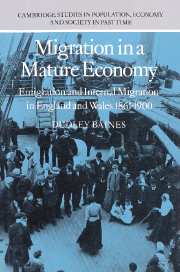Book contents
- Frontmatter
- Contents
- List of tables
- List of figures
- Acknowledgements
- 1 Introduction: the scope of the study
- 2 Issues in the history of European emigration, 1840–1914
- 3 The characteristics of British emigrants before 1914
- 4 The estimation of migration by county of birth
- 5 Return migration to Britain, 1860–1914
- 6 The birthplace of English and Welsh emigrants, 1861–1900
- 7 English and Welsh emigrants in the 1880s and 1890s
- 8 Emigration and urban growth
- 9 Rural-urban stage emigration, 1861–1900
- 10 Wales and the Atlantic economy, 1861–1914
- A summary of conclusions
- Appendices
- Bibliography
- Index
1 - Introduction: the scope of the study
Published online by Cambridge University Press: 24 November 2009
- Frontmatter
- Contents
- List of tables
- List of figures
- Acknowledgements
- 1 Introduction: the scope of the study
- 2 Issues in the history of European emigration, 1840–1914
- 3 The characteristics of British emigrants before 1914
- 4 The estimation of migration by county of birth
- 5 Return migration to Britain, 1860–1914
- 6 The birthplace of English and Welsh emigrants, 1861–1900
- 7 English and Welsh emigrants in the 1880s and 1890s
- 8 Emigration and urban growth
- 9 Rural-urban stage emigration, 1861–1900
- 10 Wales and the Atlantic economy, 1861–1914
- A summary of conclusions
- Appendices
- Bibliography
- Index
Summary
The emigration of between 44 and 52 million people from Europe overseas between the end of the Napoleonic Wars and the outbreak of the First World War was a phenomenon of outstanding importance which has attracted a large literature. In the last two decades, however, the direction of research into the history of European emigration has shifted. With some important exceptions, the majority of the books and papers published before 1960 were written from the viewpoint of the receiving countries. They were frequently concerned with the settlement and assimilation of nineteenth and early twentieth-century immigrants in overseas countries and also with the rigours of the passage from Europe. Less attention was paid to the social and economic conditions in those parts of Europe from which the emigrants came. The effect of this bias in the literature was that emigration from, say, Italy, Sweden, Ireland and Britain was often regarded as if it were part of a single phenomenon which was caused by population pressure, changes in (rural) society and the development of inland and overseas transport. In the last two decades, research on European emigration has tended to proceed along two main lines. The relationship between the annual rate of emigration and the social and economic characteristics of the sending and receiving countries has been subjected to formal econometric analysis. But more important, interest has centred on the detailed scrutiny of the local background and the social and economic structure of particular groups of emigrants.
- Type
- Chapter
- Information
- Migration in a Mature EconomyEmigration and Internal Migration in England and Wales 1861–1900, pp. 1 - 7Publisher: Cambridge University PressPrint publication year: 1986

